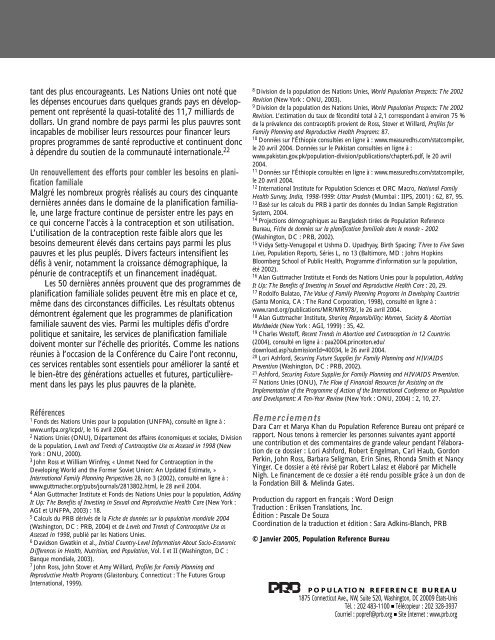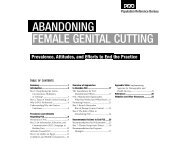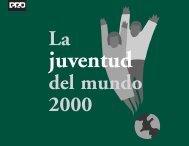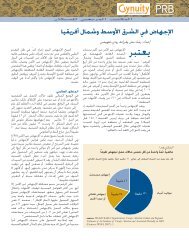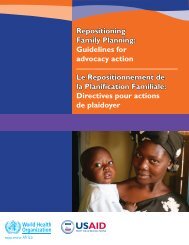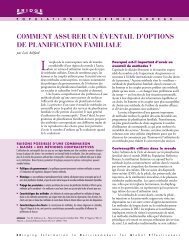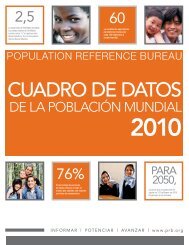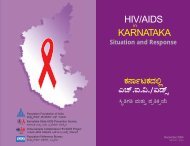le projet inachevé : répondre aux besoins en planification familiale ...
le projet inachevé : répondre aux besoins en planification familiale ...
le projet inachevé : répondre aux besoins en planification familiale ...
Create successful ePaper yourself
Turn your PDF publications into a flip-book with our unique Google optimized e-Paper software.
The Healthy Newborn Partnership: Improving Newborn Survival and Health Through Partnership, Policy, and Action n July 2004<br />
tant des plus <strong>en</strong>courageants. Les Nations Unies ont noté que<br />
<strong>le</strong>s dép<strong>en</strong>ses <strong>en</strong>courues dans quelques grands pays <strong>en</strong> développem<strong>en</strong>t<br />
ont représ<strong>en</strong>té la quasi-totalité des 11,7 milliards de<br />
dollars. Un grand nombre de pays parmi <strong>le</strong>s plus pauvres sont<br />
incapab<strong>le</strong>s de mobiliser <strong>le</strong>urs ressources pour financer <strong>le</strong>urs<br />
propres programmes de santé reproductive et continu<strong>en</strong>t donc<br />
à dép<strong>en</strong>dre du souti<strong>en</strong> de la communauté internationa<strong>le</strong>. 22<br />
Un r<strong>en</strong>ouvel<strong>le</strong>m<strong>en</strong>t des efforts pour comb<strong>le</strong>r <strong>le</strong>s <strong>besoins</strong> <strong>en</strong> <strong>planification</strong><br />
familia<strong>le</strong><br />
Malgré <strong>le</strong>s nombreux progrès réalisés au cours des cinquante<br />
dernières années dans <strong>le</strong> domaine de la <strong>planification</strong> familia<strong>le</strong>,<br />
une large fracture continue de persister <strong>en</strong>tre <strong>le</strong>s pays <strong>en</strong><br />
ce qui concerne l’accès à la contraception et son utilisation.<br />
L’utilisation de la contraception reste faib<strong>le</strong> alors que <strong>le</strong>s<br />
<strong>besoins</strong> demeur<strong>en</strong>t é<strong>le</strong>vés dans certains pays parmi <strong>le</strong>s plus<br />
pauvres et <strong>le</strong>s plus peuplés. Divers facteurs int<strong>en</strong>sifi<strong>en</strong>t <strong>le</strong>s<br />
défis à v<strong>en</strong>ir, notamm<strong>en</strong>t la croissance démographique, la<br />
pénurie de contraceptifs et un financem<strong>en</strong>t inadéquat.<br />
Les 50 dernières années prouv<strong>en</strong>t que des programmes de<br />
<strong>planification</strong> familia<strong>le</strong> solides peuv<strong>en</strong>t être mis <strong>en</strong> place et ce,<br />
même dans des circonstances diffici<strong>le</strong>s. Les résultats obt<strong>en</strong>us<br />
démontr<strong>en</strong>t éga<strong>le</strong>m<strong>en</strong>t que <strong>le</strong>s programmes de <strong>planification</strong><br />
familia<strong>le</strong> sauv<strong>en</strong>t des vies. Parmi <strong>le</strong>s multip<strong>le</strong>s défis d’ordre<br />
politique et sanitaire, <strong>le</strong>s services de <strong>planification</strong> familia<strong>le</strong><br />
doiv<strong>en</strong>t monter sur l’échel<strong>le</strong> des priorités. Comme <strong>le</strong>s nations<br />
réunies à l’occasion de la Confér<strong>en</strong>ce du Caire l’ont reconnu,<br />
ces services r<strong>en</strong>tab<strong>le</strong>s sont ess<strong>en</strong>tiels pour améliorer la santé et<br />
<strong>le</strong> bi<strong>en</strong>-être des générations actuel<strong>le</strong>s et futures, particulièrem<strong>en</strong>t<br />
dans <strong>le</strong>s pays <strong>le</strong>s plus pauvres de la planète.<br />
Référ<strong>en</strong>ces<br />
1 Fonds des Nations Unies pour la population (UNFPA), consulté <strong>en</strong> ligne à :<br />
www.unfpa.org/icpd/, <strong>le</strong> 16 avril 2004.<br />
2 Nations Unies (ONU), Départem<strong>en</strong>t des affaires économiques et socia<strong>le</strong>s, Division<br />
de la population, Levels and Tr<strong>en</strong>ds of Contraceptive Use as Assessed in 1998 (New<br />
York : ONU, 2000).<br />
3 John Ross et William Winfrey, « Unmet Need for Contraception in the<br />
Developing World and the Former Soviet Union: An Updated Estimate, »<br />
International Family Planning Perspectives 28, no 3 (2002), consulté <strong>en</strong> ligne à :<br />
www.guttmacher.org/pubs/journals/2813802.html, <strong>le</strong> 28 avril 2004.<br />
4 Alan Guttmacher Institute et Fonds des Nations Unies pour la population, Adding<br />
It Up: The B<strong>en</strong>efits of Investing in Sexual and Reproductive Health Care (New York :<br />
AGI et UNFPA, 2003) : 18.<br />
5 Calculs du PRB dérivés de la Fiche de données sur la population mondia<strong>le</strong> 2004<br />
(Washington, DC : PRB, 2004) et de Levels and Tr<strong>en</strong>ds of Contraceptive Use as<br />
Assessed in 1998, publié par <strong>le</strong>s Nations Unies.<br />
6 Davidson Gwatkin et al., Initial Country-Level Information About Socio-Economic<br />
Differ<strong>en</strong>ces in Health, Nutrition, and Population, Vol. I et II (Washington, DC :<br />
Banque mondia<strong>le</strong>, 2003).<br />
7 John Ross, John Stover et Amy Willard, Profi<strong>le</strong>s for Family Planning and<br />
Reproductive Health Programs (Glastonbury, Connecticut : The Futures Group<br />
International, 1999).<br />
8 Division de la population des Nations Unies, World Population Prospects: The 2002<br />
Revision (New York : ONU, 2003).<br />
9 Division de la population des Nations Unies, World Population Prospects: The 2002<br />
Revision. L’estimation du t<strong>aux</strong> de fécondité total à 2,1 correspondant à <strong>en</strong>viron 75 %<br />
de la préva<strong>le</strong>nce des contraceptifs provi<strong>en</strong>t de Ross, Stover et Willard, Profi<strong>le</strong>s for<br />
Family Planning and Reproductive Health Programs: 87.<br />
10 Données sur l’Éthiopie consultées <strong>en</strong> ligne à : www.measuredhs.com/statcompi<strong>le</strong>r,<br />
<strong>le</strong> 20 avril 2004. Données sur <strong>le</strong> Pakistan consultées <strong>en</strong> ligne à :<br />
www.pakistan.gov.pk/population-division/publications/chapter6.pdf, <strong>le</strong> 20 avril<br />
2004.<br />
11 Données sur l’Éthiopie consultées <strong>en</strong> ligne à : www.measuredhs.com/statcompi<strong>le</strong>r,<br />
<strong>le</strong> 20 avril 2004.<br />
12 International Institute for Population Sci<strong>en</strong>ces et ORC Macro, National Family<br />
Health Survey, India, 1998-1999: Uttar Pradesh (Mumbai : IIPS, 2001) : 62, 87, 95.<br />
13 Basé sur <strong>le</strong>s calculs du PRB à partir des données du Indian Samp<strong>le</strong> Registration<br />
System, 2004.<br />
14 Projections démographiques au Bangladesh tirées de Population Refer<strong>en</strong>ce<br />
Bureau, Fiche de données sur la <strong>planification</strong> familia<strong>le</strong> dans <strong>le</strong> monde - 2002<br />
(Washington, DC : PRB, 2002).<br />
15 Vidya Setty-V<strong>en</strong>ugopal et Ushma D. Upadhyay, Birth Spacing: Three to Five Saves<br />
Lives, Population Reports, Séries L, no 13 (Baltimore, MD : Johns Hopkins<br />
Bloomberg School of Public Health, Programme d’information sur la population,<br />
été 2002).<br />
16 Alan Guttmacher Institute et Fonds des Nations Unies pour la population, Adding<br />
It Up: The B<strong>en</strong>efits of Investing in Sexual and Reproductive Health Care : 20, 29.<br />
17 Rodolfo Bulatao, The Value of Family Planning Programs in Developing Countries<br />
(Santa Monica, CA : The Rand Corporation, 1998), consulté <strong>en</strong> ligne à :<br />
www.rand.org/publications/MR/MR978/, <strong>le</strong> 26 avril 2004.<br />
18 Alan Guttmacher Institute, Sharing Responsibility: Wom<strong>en</strong>, Society & Abortion<br />
Worldwide (New York : AGI, 1999) : 35, 42.<br />
19 Char<strong>le</strong>s Westoff, Rec<strong>en</strong>t Tr<strong>en</strong>ds in Abortion and Contraception in 12 Countries<br />
(2004), consulté <strong>en</strong> ligne à : paa2004.princeton.edu/<br />
download.asp?submissionId=40034, <strong>le</strong> 26 avril 2004.<br />
20 Lori Ashford, Securing Future Supplies for Family Planning and HIV/AIDS<br />
Prev<strong>en</strong>tion (Washington, DC : PRB, 2002).<br />
21 Ashford, Securing Future Supplies for Family Planning and HIV/AIDS Prev<strong>en</strong>tion.<br />
22 Nations Unies (ONU), The Flow of Financial Resources for Assisting on the<br />
Imp<strong>le</strong>m<strong>en</strong>tation of the Programme of Action of the International Confer<strong>en</strong>ce on Population<br />
and Developm<strong>en</strong>t: A T<strong>en</strong>-Year Review (New York : ONU, 2004) : 2, 10, 27.<br />
Remerciem<strong>en</strong>ts<br />
Dara Carr et Marya Khan du Population Refer<strong>en</strong>ce Bureau ont préparé ce<br />
rapport. Nous t<strong>en</strong>ons à remercier <strong>le</strong>s personnes suivantes ayant apporté<br />
une contribution et des comm<strong>en</strong>taires de grande va<strong>le</strong>ur p<strong>en</strong>dant l’élaboration<br />
de ce dossier : Lori Ashford, Robert Engelman, Carl Haub, Gordon<br />
Perkin, John Ross, Barbara Seligman, Erin Sines, Rhonda Smith et Nancy<br />
Yinger. Ce dossier a été révisé par Robert Lalasz et élaboré par Michel<strong>le</strong><br />
Nigh. Le financem<strong>en</strong>t de ce dossier a été r<strong>en</strong>du possib<strong>le</strong> grâce à un don de<br />
la Fondation Bill & Melinda Gates.<br />
Production du rapport <strong>en</strong> français : Word Design<br />
Traduction : Eriks<strong>en</strong> Translations, Inc.<br />
Édition : Pasca<strong>le</strong> De Souza<br />
Coordination de la traduction et édition : Sara Adkins-Blanch, PRB<br />
© Janvier 2005, Population Refer<strong>en</strong>ce Bureau<br />
POPULATION REFERENCE BUREAU<br />
1875 Connecticut Ave., NW, Suite 520, Washington, DC 20009 États-Unis<br />
Tél. : 202 483-1100 ■ Télécopieur : 202 328-3937<br />
Courriel : popref@prb.org ■ Site Internet : www.prb.org


